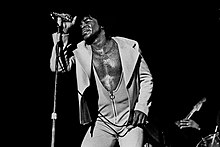
Back Funk (Musik) ALS فانك Arabic فانك ARZ Funk AST Фанк Byelorussian Фънк Bulgarian Funk Breton Funk Catalan فەنک CKB Fank CRH
| Funk | |
|---|---|
 James Brown, a pioneer of funk, in 1973 | |
| Stylistic origins | |
| Cultural origins | Mid-1960s,[1] United States |
| Derivative forms | |
| Subgenres | |
| Fusion genres | |
| Other topics | |
Funk is a music genre that originated in African-American communities in the mid-1960s when musicians created a rhythmic, danceable new form of music through a mixture of various music genres that were popular among African-Americans in the mid-20th century. It deemphasizes melody and chord progressions and focuses on a strong rhythmic groove of a bassline played by an electric bassist and a drum part played by a percussionist, often at slower tempos than other popular music. Funk typically consists of a complex percussive groove with rhythm instruments playing interlocking grooves that create a "hypnotic" and "danceable" feel.[3] It uses the same richly colored extended chords found in bebop jazz, such as minor chords with added sevenths and elevenths, and dominant seventh chords with altered ninths and thirteenths.
Funk originated in the mid-1960s, with James Brown's development of a signature groove that emphasized the downbeat—with a heavy emphasis on the first beat of every measure ("The One"), and the application of swung 16th notes and syncopation on all basslines, drum patterns, and guitar riffs.[4] Rock- and psychedelia-influenced musicians Sly and the Family Stone and Parliament-Funkadelic fostered more eclectic examples of the genre beginning in the late 1960s.[5] Other musical groups developed Brown's innovations during the 1970s and the 1980s, including Kool and the Gang,[6] Ohio Players, Fatback Band, Jimmy Castor Bunch, Earth, Wind & Fire, B.T. Express, Shalamar,[7] One Way, Lakeside, Dazz Band, The Gap Band, Slave, Aurra, Roger Troutman & Zapp, Con Funk Shun, Cameo, Bar-Kays and Chic.
Funk derivatives include avant-funk, an avant-garde strain of funk; boogie, a hybrid of electronic music and funk; funk metal; G-funk, a mix of gangsta rap and psychedelic funk; Timba, a form of funky Cuban dance music; and funk jam. It is also the main influence of Washington go-go, a funk subgenre.[8] Funk samples and breakbeats have been used extensively in hip hop and electronic dance music.
- ^ Cite error: The named reference
encyclopediawas invoked but never defined (see the help page). - ^ Fontenot, Robert (February 24, 2019). "What Is Swamp Rock? A look at this Southern mix of country, funk, and soul". Liveabout. Retrieved November 9, 2022.
- ^ Stewart, Dave (July 2015). "Top Brass: Part 2 Arranging For Brass". soundonsound.com. Sound on Sound. Retrieved April 18, 2019.
- ^ Slutsky, Allan, Chuck Silverman (1997). The Funkmasters-the Great James Brown Rhythm Sections. ISBN 1-57623-443-6
- ^ Explore: "Funk." Rhythmne. Retrieved 2020-09-16.
- ^ "KOOL & THE GANG". njhalloffame.org. New Jersey Hall of Fame. June 26, 2015.
- ^ Bohannon Biography AllMusic. Retrieved 14 March 2023
- ^ Vincent, Rickey (1996). Funk: The Music, the People, and the Rhythm of the One. New York: St. Martin's Press. pp. 293–297. ISBN 978-0-312-13499-0.